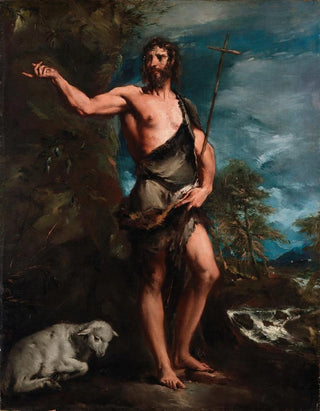Art print | Saint John the Baptist in the Wilderness after Titian - Antonio Guardi Source: Reproduction | Saint Jean-Baptiste au désert d'après Titien - Antonio Guardi


View from behind

Frame (optional)
Antonio Guardi's work, "Saint John the Baptist in the Wilderness after Titian," is a captivating reinterpretation of a classic theme rooted in Renaissance art. This art print, while respecting the essence of Titian's masterpiece, offers a fresh perspective on the iconic figure of Saint John the Baptist, a central character in Christianity. The piece evokes a return to nature, solitude, and contemplation—themes that resonate deeply within the human soul. Inspired by the Venetian master, the artist manages to capture an atmosphere of mystery and spirituality, inviting viewers to engage in a silent dialogue with the saint.
Style and uniqueness of the art print
Guardi's style is distinguished by his ability to blend tradition with personal sensitivity. In this art print, vibrant colors and play of light recall Titian's techniques, yet the artist infuses it with a touch of lightness and fluidity. The composition is carefully orchestrated, with each element seemingly harmonizing with the others. The drapery of Saint John’s garment, for example, is rendered with delicacy that suggests the movement of the wind, while the surrounding landscape, both wild and serene, contributes to the spiritual elevation of the scene. Guardi's chosen color palette, oscillating between earthy tones and luminous highlights, creates an atmosphere that is both soothing and striking, encouraging introspection on solitude and faith.
The artist and his influence
Antonio Guardi, a member of an artistic family, has made a name for himself in the art world by drawing inspiration from great masters while developing his own style. His work, deeply rooted in Venetian tradition, stands out for its more intimate and personal approach. Guardi often explored religious themes, and his vision of Saint John the Baptist reflects a profound understanding of human psychology and spirituality. His influence is evident in the art world, where he has paved the way for new interpretations of classic subjects.

Matte finish

View from behind

Frame (optional)
Antonio Guardi's work, "Saint John the Baptist in the Wilderness after Titian," is a captivating reinterpretation of a classic theme rooted in Renaissance art. This art print, while respecting the essence of Titian's masterpiece, offers a fresh perspective on the iconic figure of Saint John the Baptist, a central character in Christianity. The piece evokes a return to nature, solitude, and contemplation—themes that resonate deeply within the human soul. Inspired by the Venetian master, the artist manages to capture an atmosphere of mystery and spirituality, inviting viewers to engage in a silent dialogue with the saint.
Style and uniqueness of the art print
Guardi's style is distinguished by his ability to blend tradition with personal sensitivity. In this art print, vibrant colors and play of light recall Titian's techniques, yet the artist infuses it with a touch of lightness and fluidity. The composition is carefully orchestrated, with each element seemingly harmonizing with the others. The drapery of Saint John’s garment, for example, is rendered with delicacy that suggests the movement of the wind, while the surrounding landscape, both wild and serene, contributes to the spiritual elevation of the scene. Guardi's chosen color palette, oscillating between earthy tones and luminous highlights, creates an atmosphere that is both soothing and striking, encouraging introspection on solitude and faith.
The artist and his influence
Antonio Guardi, a member of an artistic family, has made a name for himself in the art world by drawing inspiration from great masters while developing his own style. His work, deeply rooted in Venetian tradition, stands out for its more intimate and personal approach. Guardi often explored religious themes, and his vision of Saint John the Baptist reflects a profound understanding of human psychology and spirituality. His influence is evident in the art world, where he has paved the way for new interpretations of classic subjects.






